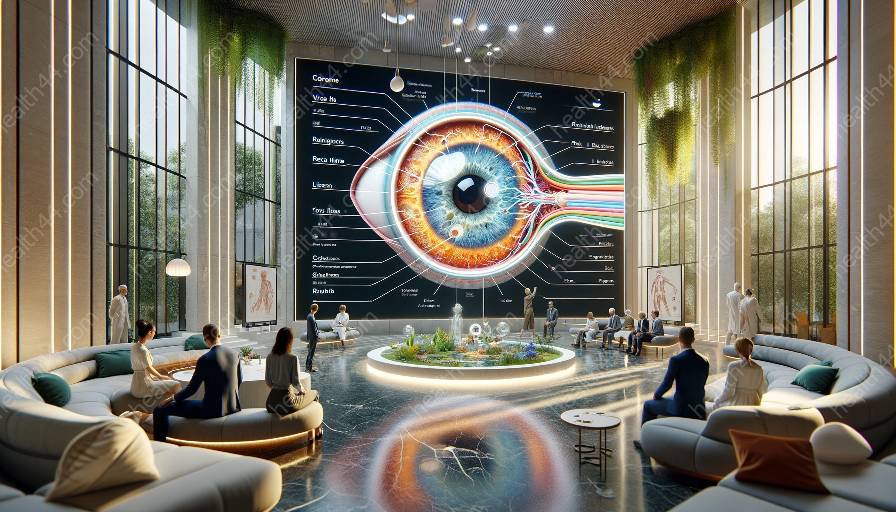Understanding the role of genetics in determining eye color and susceptibility to certain eye diseases involves exploring the complex interplay between genetic factors, eye anatomy, and vision rehabilitation.
Genetics and Eye Color
Eye color is a hereditary trait that is determined by the amount and distribution of melanin in the iris of the eye. Melanin is a pigment that gives color to the skin, hair, and eyes. The genetics of eye color inheritance is complex and involves multiple genes.
Two main genes that are known to play a significant role in eye color determination are OCA2 and HERC2. The OCA2 gene provides instructions for making a protein involved in the production of melanin, while the HERC2 gene regulates the expression of the OCA2 gene. Variations in these genes can contribute to the diversity of eye colors found in different individuals.
While there are certain eye colors that are more common in specific populations, such as brown eyes in many ethnic groups, the inheritance of eye color is not as straightforward as previously thought. It is not only the direct genetic inheritance from parents that determines an individual’s eye color but also the complex interactions of multiple genes and environmental factors.
Genetics and Eye Diseases
The influence of genetics on susceptibility to certain eye diseases is a topic of extensive research in ophthalmology. Many eye diseases have a genetic component, meaning that certain genetic variations or mutations can increase the risk of developing these conditions.
For example, conditions such as glaucoma, age-related macular degeneration, diabetic retinopathy, and retinitis pigmentosa have been linked to specific genetic factors. In some cases, the inheritance pattern of these diseases follows a Mendelian fashion, while in others, the genetic risk factors interact with environmental and lifestyle factors to influence disease development.
Understanding the genetic basis of eye diseases has significant implications for early detection, prevention, and personalized treatment. Genetic testing and counseling can provide valuable insights into an individual’s risk of developing certain eye diseases and guide healthcare professionals in developing tailored management plans.
Eye Anatomy and Genetic Expression
The intricate structures within the eye, including the cornea, iris, lens, and retina, are all influenced by genetic expression. The genetic instructions for the development and functioning of these components play a crucial role in determining an individual’s visual acuity, color perception, and susceptibility to certain eye conditions.
For instance, variations in genes that regulate the development of the crystalline lens can result in conditions such as cataracts, where the lens becomes cloudy, leading to vision impairment. Similarly, mutations in genes related to the formation of the retina can impact its structure and function, leading to disorders such as retinitis pigmentosa or macular degeneration.
The impact of genetic factors on eye anatomy underscores the importance of comprehensive eye examinations that encompass both genetic and environmental risk factors to provide a holistic approach to vision care.
Vision Rehabilitation and Genetics
Advancements in vision rehabilitation are increasingly guided by insights into the genetic underpinnings of eye conditions. Understanding an individual's genetic predisposition to certain eye diseases can inform the development of personalized rehabilitation strategies that aim to optimize visual function and quality of life.
For individuals with inherited retinal conditions, such as retinitis pigmentosa, genetic counseling can offer valuable support in understanding the progression of the disease and exploring available rehabilitation options. Furthermore, genetic testing can aid in prognostication and decision-making regarding interventions such as retinal implants or gene therapies.
Moreover, the integration of genetic information into the design of low vision aids, such as customized visual aids or assistive technologies, holds promise in enhancing the independence and mobility of individuals with inherited visual impairments.
Conclusion
The role of genetics in determining eye color and susceptibility to certain eye diseases is a multifaceted and evolving field that intertwines with the intricacies of eye anatomy and the advancements in vision rehabilitation. By comprehensively understanding the genetic factors that influence eye health, healthcare professionals can tailor preventive measures, diagnostic approaches, and rehabilitation strategies to optimize visual outcomes and improve the overall well-being of individuals with inherited visual traits and conditions.





















